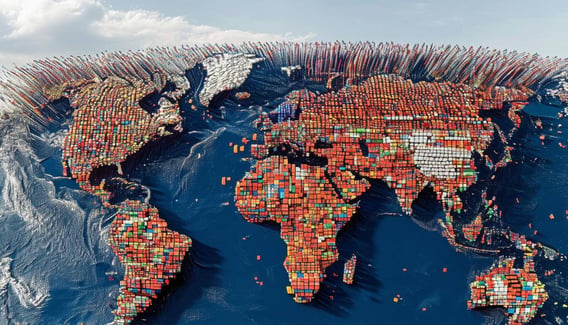Navigating the Storm: How Global Trade Tensions Will Impact Your Supply Chain

Written by Patrick Froh
In the ever-evolving landscape of global trade, the recent escalation in U.S.-China trade tensions has sent ripples through the supply chain. With retaliatory tariffs affecting a staggering $23.6 billion in trade, businesses are bracing for impact.
The Trade Tango: As the U.S. and China engage in a tit-for-tat tariff dance, the stakes are high. The White House has imposed matching 25% tariffs on goods from Canada and Mexico, and an additional 10% on Chinese imports. The stated goal? Curbing the flow of fentanyl from China via Mexico and Canada.
While tariffs on Mexico and Canada have been paused for now, China's tariffs appear to be firmly in place. Same goes for the tariff on steel imports to the United States from all countries, including Canada and Mexico. These new tariffs are certain to increase the price of steel, based on the rules of supply and demand combined with less competition. Equally certain to wreak havoc are the yet-to-be-solidified retaliatory tariffs.
Impact on Key Sectors: The full set of tariffs - if enacted - represent a significant chunk of trade, including $4.5 billion in coal and natural gas at a 15% rate, $6.0 billion in crude oil at 10%, and various agricultural machinery and vehicles at 10%. These tariffs account for 13.4% of China's imports to the U.S. last year. China, in turn, has levied 15% tariffs on coal and natural gas and 10% on oil, farm equipment, and vehicles.
Supply Chain Strategies: So, what can shippers do to mitigate these tariff pressures? Chris Rogers, S&P Global Market Intelligence research director, suggests passing through higher tariff expenses via price increases, depending on market power relative to competitors. Additionally, businesses can explore reshoring—bringing manufacturing back home - to navigate tariff uncertainty and mitigate supply chain risks.
Example: Qualcomm's Predicament: One notable example of a company affected by these trade tensions is Qualcomm. The semiconductor giant faces significant risks due to its heavy reliance on the Chinese smartphone market. Qualcomm's licensing business model, which depends on Chinese manufacturers paying royalties for wireless technology patents, is under pressure. Rising competition from domestic Chinese players like HiSilicon, coupled with potential trade restrictions, threatens both Qualcomm's chip sales and intellectual property revenue streams. There are many of these complex entanglements, so time will tell the significance of the net results.
Conclusion: In the face of these challenges, supply chain professionals must remain agile and proactive. By leveraging advanced analytics, scenario modeling, and network design, businesses can build resilient supply chains that thrive amidst uncertainty.
In the world of supply chain, it's not just about weathering the storm—it's about dancing in the rain.
Call to Action: Stay informed and stay ahead. Follow us for more insights and strategies to navigate the ever-changing landscape of global trade.





